Weep holes in retaining walls: What are they?
by Mitul Dalwadi, on November 23, 2023
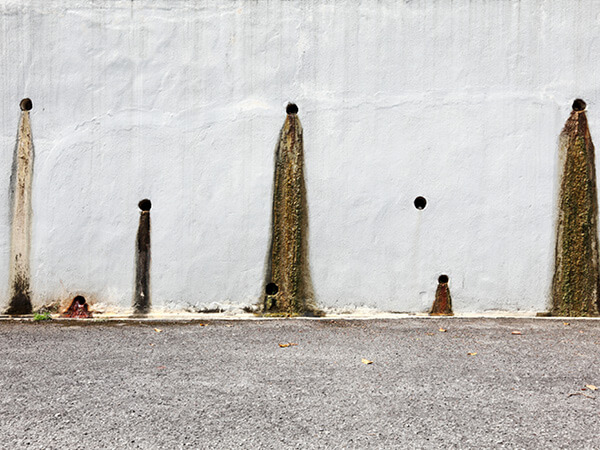.jpg)
Figure 1 - Weep holes in a concrete wall with staining. Effective but not attractive
Weep holes are a crucial component in the design and construction of retaining walls, serving several vital functions that contribute to the overall stability and longevity of the structure. Without proper drainage, water can accumulate in the soil behind the retaining wall, exerting excessive pressure that may lead to structural failure, cracking, or even collapse.
Weep holes are also found in other building locations, such as brick walls in housing and window frames, to prevent moisture buildup and the risk of mould and structural deterioration.
In this guide, we’ll take a closer look at what weep holes in retaining walls are and their importance, especially for water drainage, before touching on why Tensar retaining wall systems are less in need of them.
Interested in one particular section? Use the links below to navigate to it.
- What are weep holes in retaining walls?
- Why are weep holes important in retaining walls?
- What are the different types of weep holes?
- How can water get into the soil behind a retaining wall?
- Weep holes and the need for drainage behind retaining walls
- How weep holes and wall water drainage work together
- A better drainage solution with Tensar retaining walls
- Next steps
If you are considering whether you’ll require weep holes for adequate drainage on an upcoming project, Tensar can help. Request a free design assessment or get in touch with our team to find out more.
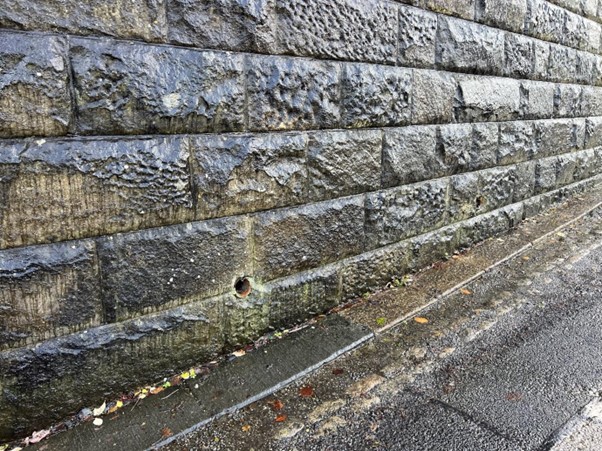
Figure 2 - Weep holes set at regular intervals along the base of this masonry wall
What are weep holes in retaining walls?
Weep holes in retaining walls are small openings or perforations that allow water to escape. They prevent the build-up of water in the soil retained by the wall, which would otherwise cause increased lateral pressure, resulting in the failure of the structure.
You’ll typically find weep holes forming a line of openings at regular intervals close to the bottom of a retaining wall. In higher walls, particularly those of older structures, additional rows of weep holes may be visible higher up the wall to enhance the retaining wall's drainage.
In masonry walls, a weep hole may be formed by leaving a spacing in a vertical joint. For concrete walls, the weep hole is usually formed by casting in a short length of plastic pipe, laid slightly sloping downward towards the front of the wall.
Why are weep holes important for retaining walls?
Weep holes are a crucial component of retaining walls and block retaining wall drainage. The common function of retaining walls is to create a difference in level between the ground at the top and the area in front of the wall by supporting a height of retained soil. They must therefore be designed to support the soil pressure acting on the back of the wall.
If water is allowed to build up behind the wall, this increases lateral pressure acting on the wall, which can compromise the soil's stability and reduce its bearing capacity. Unless this is properly considered in the design, it could lead to failure. Weep holes can alleviate this problem by ensuring that water drains from the retained soil. The effectiveness of weep holes can be improved by incorporating a zone of drainage aggregate behind the wall, continuous between weep holes.
The advantages of weep holes
If the weep holes in retaining walls are correctly spaced, this can avoid the buildup of water in the soil behind the wall. Weep holes are usually spaced every 4 to 4 feet. The weep hole size in retaining walls is usually 2 to 4 inches in diameter, depending on the type of soil used and the water volume. This can vary as finer soils like clay need larger weep holes, while coarser soils will need smaller ones. Weep holes also prevent an increase in pressure at the back of the wall that could otherwise lead to collapse. They are simple to incorporate into all types of retaining walls, at little cost.
The disadvantages of weep holes
Over time, weep holes can become clogged with vegetation or algae growth, reducing their effectiveness. If the weep holes outfall above ground level, they can be unsightly, particularly after many years of water staining or algae growth on the wall face. The effectiveness of weep holes is limited when the retained soil consists of expansive clay, as this soil type swells when wet and shrinks when dry. It can increase lateral pressure on the wall, particularly if no drainage zone is incorporated behind the wall face.
What are the different types of weep holes?
Weep holes can be formed in a retaining wall during construction very simply and at little cost. The method of forming the weep hole will depend to some extent on the type of retaining wall.
Open joint method
Suitable for the masonry of stone-built retaining walls. At regular intervals, the vertical joint is left open without mortar, and the blocks are placed slightly wider apart to create a continuous channel through the wall.
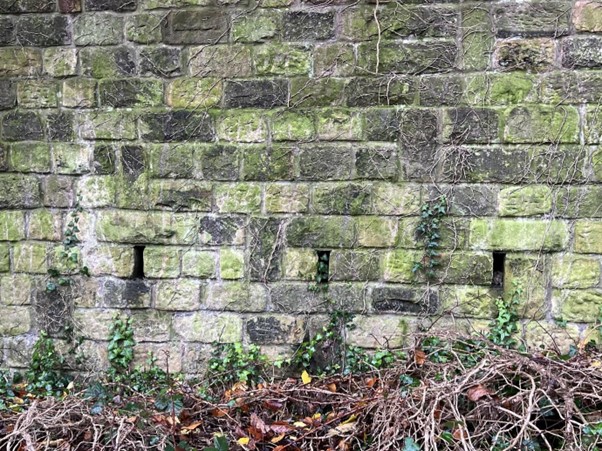
Figure 3 - Weep holes in a stone block wall formed by leaving open joints
Tube insert method
This method is the only one suitable for in-situ concrete walls. It is also best used for masonry walls that are greater than one block thickness at the base. A pipe, usually plastic, is cast into the concrete or built into masonry to form the weep hole. In older structures, clay pipes were used. The pipe is usually set at a slight downward incline towards the wall face.
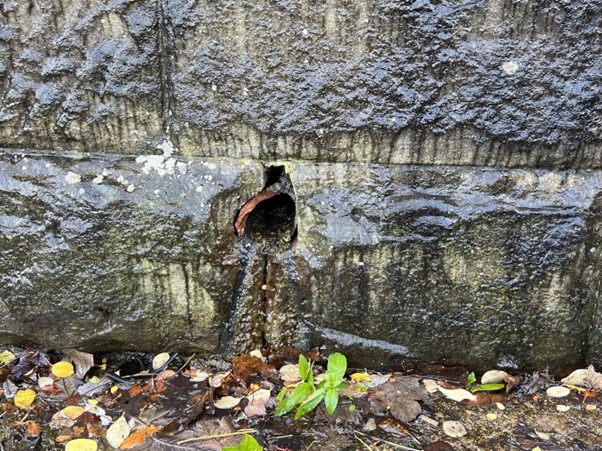
Figure 4 - Clay pipe was used to form weep holes, with stone cut to fit around the pipe, in this Victorian era retaining wall
Drill method
Weep holes can be added after the wall is constructed by drilling through the wall thickness. While this is relatively easy for concrete block walls, it is more time-consuming for reinforced concrete retaining walls.
How can water get into the soil behind a retaining wall?
There are three paths by which water can enter the soil fill behind a retaining wall.
1. Surface water ingress
Water flowing across the ground at the top of the wall can seep into the ground, slowly increasing the groundwater level in the retained soil. Surface water collecting at the top of the wall can seep down behind the wall face into the soil below.
2. Groundwater seepage
Water flowing naturally through the ground can enter the retained soil behind the wall.
3. Fractured pipework
It is possible that stormwater or service pipes can be damaged during or after construction due to settlement. This can lead to water entering the retained soil behind the wall.
Weep holes and the need for drainage behind retaining walls
While weep holes do reduce the water buildup behind a retaining wall, their effectiveness can be vastly improved by incorporating a drainage system within the structure. Without proper drainage, water accumulates behind the wall, increasing lateral pressure that can lead to wall deformation or failure. A zone of free-draining aggregate material placed behind the wall from the base up to within 0.5m of the top improves water flow towards the weep holes. Alternatively, permeable concrete drainage blocks can replace the drainage aggregate or a geocomposite drainage product.
As an alternative to weep holes, most new construction will connect the drainage zone to a perforated drainage pipe located behind the base of the wall outfalling to a manhole. Permeable concrete drainage blocks are typically used to form the drainage zone, as these are easier to construct than using aggregate for drainage.
Surface water must be dealt with by the provision of drainage channels at the top of the wall. While ground water flowing towards the wall can best be dealt with by incorporating a cut-off drain behind the retained fill. This is usually a layer of drainage aggregate placed on the sloping excavation and across to the base of the wall, before placing the retained soil. Again, the use of a geotextile filter below the drainage layer is a precaution against contamination and clogging of the aggregate.
How weep holes and wall water drainage work together
Weep holes act as outlet points for water collected by the zone of drainage for retaining wall. Positioned at regular intervals near the base of the wall, they allow water to exit, preventing pressure build-up. However, weep holes alone are not sufficient if the water cannot reach them. That’s why:
- Drainage aggregates channel water horizontally to the weep holes.
- Perforated pipes beneath the drainage aggregates carry water away from the wall base.
- Geotextiles filter fine soil particles, preventing clogging of the drainage system.
Together, these components form a reliable wall drainage system that extends the life of retaining walls by mitigating water damage and reducing structural stress.
A better drainage solution with Tensar retaining walls
TensarTech Retaining Wall Systems do not require weep holes. In our solution, there are three types of concrete facing available: blocks, segmental panels, and full-height panels. In all these systems, the modular facing components have no mortared or sealed joints. Water can pass freely through the joints.
For the block-faced walls like Tensar Mesa Wall System, a zone of drainage aggregate is placed immediately behind the blocks. This prevents the loss of fine soil through the facing and also reduces block displacement during backfilling. Water is channelled down through the drainage zone to the base of the wall, where it passes into a collector pipe behind the wall. Alternatively, the collector pipe can be laid below ground, in front of the wall. Water passes through the open joints in the blockwork and into the collector pipe. This has the advantage that the pipe is accessible for future maintenance.
For the segmental panel and full-height panel systems, drainage can take place through the joints between panels. Geotextile strips are placed behind the wall panels to cover all joints, preventing the loss of fine soil through the wall face. The use of a drainage zone behind panels is still advisable to conduct water down to the base. This avoids water staining on the face. In all cases, where groundwater is present and flowing towards the back of the structure, a cut-off drain is incorporated behind and below the retained fill.
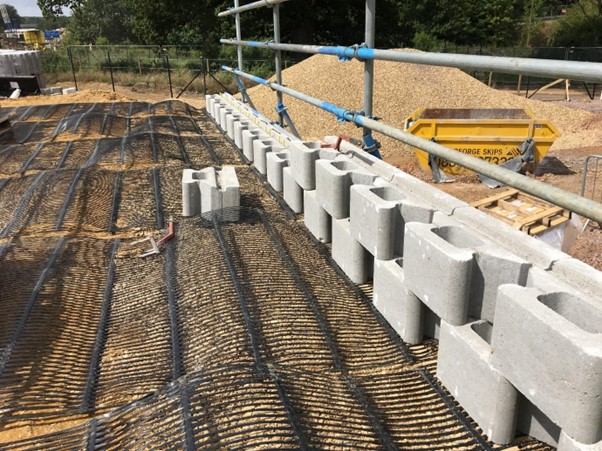
Figure 5 - A drainage zone is incorporated between the retained fill and the facing blocks of this TensarTech TW3 retaining wall
For more information, take a look at all of Tensar’s retaining wall systems:
- TW1 Wall System
- TW3 Wall System
- TR2 Wall System
- Rockwall System
- Mesa Wall System
- NaturalGreen Slope System
- GreenSlope System
- Eco-Crib Wall System
Next steps
It is important to understand the need for drainage in all retaining wall types. Weep holes in existing walls are a visible reminder of that. However, unsightly weep holes can be avoided by selecting a TensarTech Retaining Wall System. For advice on selecting the appropriate wall system for your project, Tensar can help. Contact us for any questions or enquiries or request a free design assessment to discover the value Tensar can add.
If you enjoyed our article about weep holes in retaining walls, you may be interested in these other guides:
- Pore water pressure and the importance of drainage
- What is a reinforced soil wall?
- What are the different types of retaining walls?
- The benefits of load-bearing reinforced soil walls



.jpg?width=400&height=400&ext=.jpg)